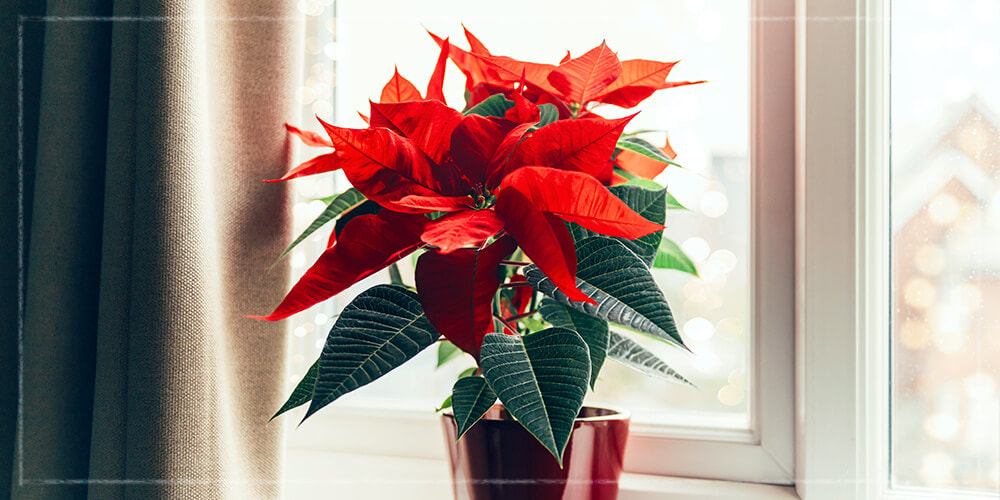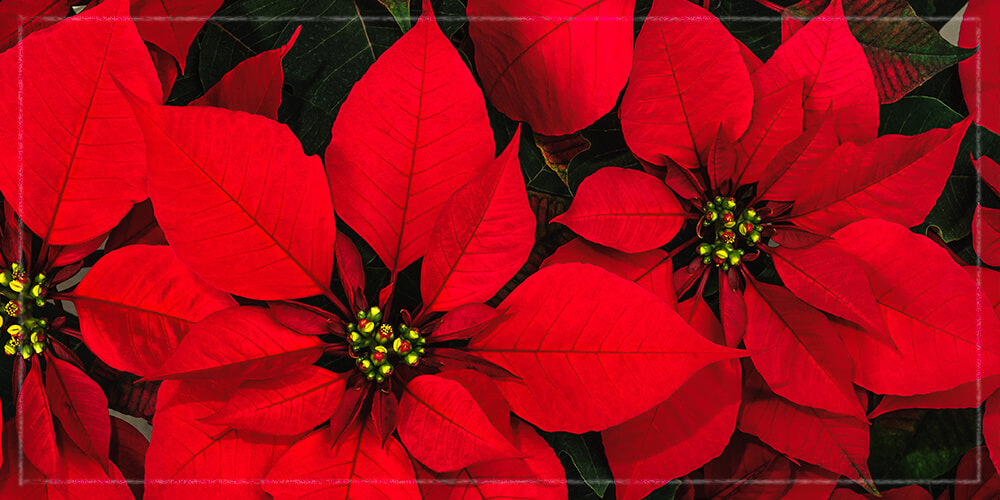Are you thinking of brightening your home with a poinsettia for the holidays? Or, perhaps you’ve already fallen in love with one and brought it home. Either way, the poinsettia is a lovely plant both for Christmas and year-round, if you choose to keep it, as it’s perfectly capable of living a long life. Plus, caring for a poinsettia plant indoors is easy-peasy. Here’s how to care for poinsettias!
Poinsettia Care Instructions
1. Choose a healthy plant. If you don’t have your poinsettia yet, be sure to pick a healthy one. Signs of health include thick, deep green foliage and firm, colorful flowers.
2. Protect it from the cold when you bring it home. While our North Carolina winter is milder than many, the cold from outdoors could still be a shock to your poinsettia, which is a tropical plant native to Mexico. So when you take it home, protect it from that cold outdoor air by covering it with a cellophane bag or pillowcase.
3. Put it in a sunny, warm place. Like real estate, poinsettia care is all about location, location, location. Once you get your plant home, put it in a spot that’s both sunny and warm.

4. Meet its sun and light requirements. The poinsettia prefers a minimum of 6 hours of bright sunlight each day. A pro tip: to get the Christmas-time bloom period to last as long as possible, also ensure that your poinsettia gets at least 12 hours of darkness each night. An easy way to remember to meet this requirement is to put the poinsettia in a dark place when the sun sets and return it to its sunny location when the sun rises.
5. Meet its warmth requirements. As already mentioned, the poinsettia is quite sensitive to cold. It’s happiest when it’s in a consistently warm room free of cold drafts and hot drafts, so keep it away from places like the ledge of a drafty window or radiators. Its ideal daytime temperature range is 64 to 70°F, while at night, it’s still fine if the temperature dips as low as 61°F.
6. Water it only when the soil is dry. Poinsettias often fall victim to overwatering. If your poinsettia has leaves turning yellow, that’s a strong sign you’re overwatering the plant. Water your poinsettia only when the surface of its soil has become bone-dry.
When you water it, immediately empty any water that collects in the plant pot saucer, as waterlogged soil is harmful to the plant. One efficient way to prevent waterlog and make the watering process easier is to put the saucer aside, move the plant into the sink, and water it generously. The excess water will then drain out directly into the sink, and you won’t have to fuss with emptying the saucer.

What About Poison Precautions?
Now, what about the stories of poinsettias being poisonous? Is there anything you should do to protect pets and kids from your poinsettia? As it turns out, poinsettias are not poisonous—that’s a myth. However, they’re not edible either, and in fact, are mildly toxic. So even though they’re unlikely to cause serious illness, it’s still best to keep your poinsettia out of the reach of pets and kids.
How to Care for Poinsettia Flowers
Before we answer this, first, an interesting fact: what you might think of as the flower on a poinsettia is not a flower. The colorful non-green parts of a poinsettia are actually bunches of modified leaves called bracts. In the center of the bracts are the diminutive flowers, which look like tiny yellow buds.
So how do you make those bracts last as long as possible?
- If you do all the things we recommend—like choosing a healthy plant, watering it appropriately, and keeping it at a warm, consistent room temperature—the bracts will last through the holidays and might even last long after (assuming you keep the plant).
- As we mentioned earlier, you can also increase the bracts’ longevity by making sure the plant gets at least 12 hours of darkness each night along with the minimum 6 hours of bright sunlight.
- If you’re keeping the plant after Christmas, give it some standard houseplant fertilizer in January. This will give the plant a nutrient boost and also help the bracts keep their color.

Holiday Plants at Carolina Seasons Nursery
Whether you’re in the market for a poinsettia or looking for other holiday plants, we have lots available. Contact us so we can check our stock for you and recommend plants that will meet your needs. Happy Holidays!

